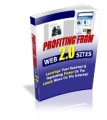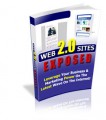Salespage Snapshot

Table of Contents
Web 2.0 Sites Exposed!
What Web 2.0 exactly is and why it is the latest wave of the Internet that is totally here to stay!
Blogging
Join the Online Journal craze and learn how a network of web logs can offer a huge boost of popularity, leads and income to your Online Empire!
Social Bookmarking
Social Bookmarking is a recognized way to store, classify, share and search links through the practice of folksonomy techniques on the Internet. Learn how you can use it to your advantage!
Social Networking
Find out how you can have fun and do some serious business at the same time in this increasingly popular Web 2.0 as used by infamous sites such as Friendster, FacE-Book, MySpace, and more!
Audio/Video/Podcasting
In the advent of wide establishment of broadbands and wireless networks throughout the world, these digital entities become more recognized and useful than ever. Here’s how you to use it to maximize your business profits and advantage!
Sample Content Preview
The best example of Wiki technology is action on the Internet is Wikipedia. In the old Web 1.0 way to doing things the owner of a website had full control over all material that was posted to the website and only website owners could edit material posted on the website.
With the advent of Web 2.0 that idea has gone the way of the horse and buggy.
RSS Feed: The acronym RSS stands for Really Simple Syndication and is yet another Web 2.0 feature that allows the web to be driven by people rather than by the powers-that-be. Those who use RSS content use reader or aggregator technology. Users subscribe to these feeds.
The reader or aggregator then checks the user’s website and when the site has new content, it is picked up and sent to the user. That is a rather simplified explanation but that is basically how it works.
A client based reader or aggregator is a stand-alone program that is attached to an existing program such as a web browser or an email reader.
A web-based reader or aggregator makes the user’s feeds available on any computer with web access.
Podcasts or Webcasts: As broadband internet connect connections and wireless networks become more and more common throughout the entire world, the podcast or webcast is gaining in popularity.
While people do still read, they are better at looking and listening to information thanks to television, hence, the advent of podcasts or webcasts.
You can find and tune into podcasts or webcasts on almost any subject imaginable today. Those who have blogs are making use of this technology to sell products and to promote their websites in record numbers.
Web 2.0 is definitely here to stay and those who are still trying to do things the old Web 1.0 way are falling behind this wave of today and of the future. Will there be changes to Web 2.0?
Well, of course, there will be. Web 2.0 is fluid and it is every changing. New technology will be developed and as it is developed people will use it. People are, after all, the driving force of Web 2.0.
And, you might ask, just who will benefit the most from Web 2.0? It will be those who embrace the new technologies as they become available and it will be us…all of us.
The internet no longer belongs to the few and the privileged. Big business has lost its edge. The Internet and Web 2.0 has leveled the playing field.
All of us (you, me and all those who have access to the Internet) can now compete and win.
Blogging
Blogging is hot right now. It might even be called a buzz word. But it is also the wave of the future for Internet marketing. ‘Blog’ is a term that is actually a combination of two common words.
Those two common words are ‘web’ and ‘log’. They have been combined into the term ‘blog’ which is short for web log.
Blogging is the result of the use of the new technology that collectively makes what is known today and Web 2.0. You will see the term “Web 2.0 websites” used frequently but what exactly does that term mean?
Back in the murky, dusty past of the Internet (a few years ago) in 2001, there was a happening that is now referred to as the dot com bust. People who had a great deal of technical know-how built websites, promoted them and made millions on speculative ideas that were not founded in reality.
The internet was a one-way street. Those who had the technical know-how to build websites posted what they wanted their readers to know and nothing more. The Internet was a relatively new thing and people bought into this one-way communication but only for a short few years.
Fortunes were made and lost overnight. There are those who blame the dot com bust on nothing more than technological break through….and it could be that they are right.
As technological advances started making building websites easier and easier, more and more people built websites and jumped on the Internet marketing bandwagon.
They began sending out millions and millions of unsolicited marketing emails daily. These emails were known as SPAM.
SPAM got so bad that the Congress of the United States actually passed the CAN SPAM act in late 2001 and it became the law of the land in early 2002. This was actually the final puncture to the already deflating Internet bubble that let the rest of the air out.
Internet marketers were required to get permission from recipients before they could send out marketing emails and many of the companies couldn’t survive the blow. Those who did began building opt-in lists.
Opt-in lists are a big part (maybe the biggest part) of all successful Internet marketing operations that are alive and well today and that need for an opt-in list is not ever going to go away but it has been supplemented.
It has been supplemented by blogs. Now Internet marketers who have blogs can give potential opt-in list members the one thing they all want…a voice.
Blogs are now discussed in the same breath and given equal weight among successful Internet marketers as opt-in lists.
You can, of course, have one without the other but it is of far greater advantage to have both and a blog is one of the best ways available to build a long and impressive opt-in list.
Other Details- 1 Ebook (PDF), 35 Pages
- 1 Squeeze Page (HTML)
- 3 Ecovers (JPG)
- Source Doc, Source PSDS
- Year Released/Circulated: 2018
- File Size: 109,381 KB
License Details:
[YES]Can be sold
[YES]Can offer Resell Rights
[YES]Can offer Master Resell Rights
[YES]Can resell Private Label Rights
[YES]Can be edited
[YES]Can put your name as the author
[YES]Can be broken down into articles
[YES]Can be used as web or e-zine content
[YES]Can be added intomembership sites
[YES]Can be sold in any format
[YES]Can be packaged
[YES]Can be offered as a bonus
[YES]Can be sold on auction sites
[YES]Can be published offline
[YES]Can be given away (in any format)














